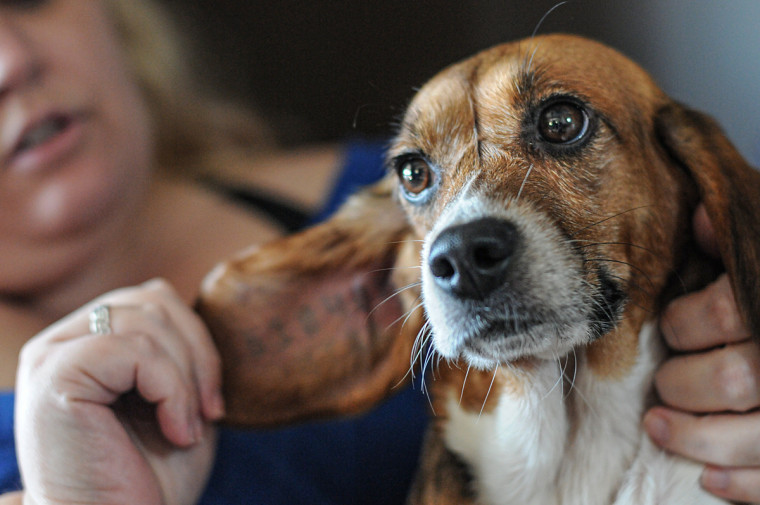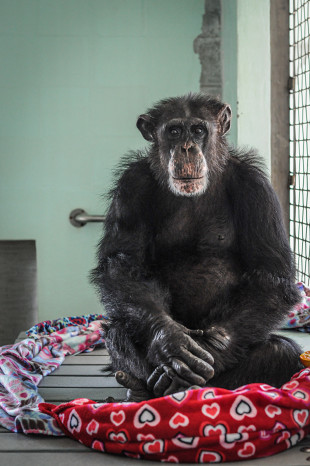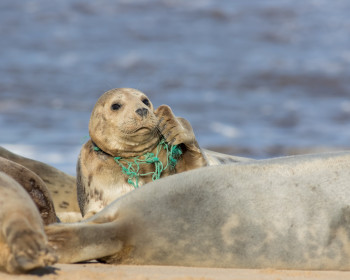Take Action for Animals Used in Research
Since 1979, April 24 has been recognized as the World Day for Laboratory Animals, commemorating the millions of animals used in scientific research and testing around the world. The Center for Animal Law Studies is raising awareness and sharing ideas for how you can help advocate for laboratory animals.
Open gallery

Photo credit to Jo-Anne McArthur / The Ghosts In Our Machine / We Animals Media showing Abbey’s tattoo. Abbey was research subject and has since been adopted.
Who Are the Animals Used in Research in the U.S.?
Almost every category of animal is used in some form of research and testing around the world. The types of animals used in research are expansive and some of the most common categories include: rats, mice, fish, birds, insects, guinea pigs, hamsters, rabbits, nonhuman primates, farmed animals (horses, goats, cows, pigs, and sheep), as well as cats.
A fact that may be surprising to some is that while dogs are considered beloved family companions in the United States and many places around the world, they are also regularly used in research facilities to be experimented on. For example, beagles are the preferred canine research subject due to the dogs’ docile nature. In fact, thousands of beagles are annually bred for the purpose of research in the U.S. and shipped in small cages to research facilities across the country. In 2023, following a lawsuit and settlement, roughly 4,000 beagles who had previously been living in horrific conditions in an Envigo research breeding facility were successfully rehomed. The federal lawsuit, subsequent settlement and eventual closure of the facility helped raise awareness of the use of dogs in research.
It is not possible to adequately quantify the total number of animals involved in scientific testing. While the United States Department of Agriculture claims that approximately 710,000 animals are used in research each year, this figure does not include the vast majority of animals used for this purpose. The federal Animal Welfare Act, which sets minimum standards for the humane treatment of animals in research facilities does not, however, protect the vast majority of animals in research, such as mice, rats, fish and birds bred for use in research. Some estimates of the true number of animals utilized in U.S. research each year range anywhere from 14 million to far beyond 110 million. On a global basis, it is estimated that close to 192 million animals were used for scientific purposes in 2015.
How Are Laboratory Animals Used in Research?
Laboratory animals are utilized for a variety of research purposes, including toxicity testing for cosmetics, drugs, household, and pet products, as well as testing the efficacy of drug treatments and psychological studies. While it may not be immediately obvious, animals may also be used in research for products designed to benefit our companion animals, such as for testing the safety of flea and tick products. In February, over 200 dogs and cats were rescued from an Oklahoma research facility where they had been subjected to painful testing for flea and tick treatments that resulted in their skin being burned off, seared, and infected.
The welfare of lab animals may be severely compromised during testing. While experiments may be invasive, stressful or painful, animals are not always provided anesthesia during testing. In fact, certain experimental protocols may be designed to test stress or pain responses, and anesthetic relief may be deliberately withheld. Besides the nonuse of anesthetics during experiments, lab animals may also suffer during their daily lives. For example, laboratory animals are typically housed in metal cages. They are also often deprived of environmental and social enrichment needs. As a result, many laboratory animals exhibit abnormal behaviors indicative of psychological trauma, such as self-mutilation and repetitive motions.
As noted by Dr. Garet Lahvis, a former animal researcher who has taught and guest lectured at Lewis & Clark Law School, laboratory animals are routinely confined despite sound research methodology that requires “healthy controls, not psychologically broken ones, to benchmark [] disease models.” As explained in his Vox article, Dr. Lahvis says: “Scientists know that the tight confinement of standard laboratory cages distorts the psychology and physiology of our animal subjects. Yet despite a half-century of evidence, we continue to cage them as if their biology is baked into their genetics.”
In some cases, countries have started recognizing the harmful nature of animal testing and have taken steps to address animal welfare. One example of animal research employs “forced swim tests” (FST), a dubious model for studying antidepressant treatments. Part of the process involves placing mice and rats in a tank of water that they cannot escape, causing distress to the animals involved. Fortunately, governments are beginning to encourage (and in some instances, mandate) a shift away from inhumane FST research. In December 2023, Australia’s National Health and Medical Research Council announced it will no longer fund most research using the model. The Australian state of New South Wales went one step further, outright banning FST experiments. And, in March 2024, the U.K.’s Home Office declared that research employing FST would undergo “enhanced scrutiny,” and that it would pursue “completely eliminat[ing] the use of the forced swim test.” The hard work of advocates, policymakers, and scientists have made these advances possible.
Shifting to Non-Animal Research Models Benefits Animals and Humans
Given the immense and often unnecessary suffering experienced by animals used in laboratories, animal and human health advocates alike have emphasized the need for advancing and transitioning to non-animal research models. Important steps have been taken in the right direction, with the law being a key tool to facilitate change.
For example, 12 U.S. states and 45 countries have enacted cosmetic testing bans. Furthermore, the American Bar Association recently passed a resolution urging national governments, including the U.S. federal government and its agencies, to promote the development and use of non-animal research models. The resolution’s accompanying report demonstrates that the prioritization of animal research alternatives would “advance animal-wellbeing, foster innovation, protect the environment, and improve the cost efficacy of taxpayer-funded research investments.” This, in turn, will “lead to safer products, better-quality medicines, and new tools for confronting future challenges and unexpected emergencies like the COVID-19 pandemic.”
In addition, in February 2024 the FDA Modernization Act 3.0 was introduced in Congress. The proposed legislation aims to reduce and replace the use of animals in nonclinical research, while also improving nonclinical testing methods’ predictivity and reducing drug development timelines—a win-win for both animals and humans.
CALS is Paving the Way through Education and Advocacy
The Center of Animal Studies (CALS) is proud to be at the forefront of training the next generation of animal advocates to effectively promote humane alternatives to animal research and champion for the protection of countless laboratory animals.

Credit: Jo-Anne McArthur / We Animals MediaSeveral courses offered at CALS highlight the plight of animals used in research and testing. For example, in Animal Law Fundamentals, students learn about the legal frameworks and ethical issues related to animal research. The course aims to provide students with a nuanced understanding of the ethics surrounding animal research and its regulation. Additionally, guest speakers offer students unique insights into the ethical, legal, and scientific concerns related to animal testing. By introducing perspectives from both sides of the debate, students are equipped with the information to form their own conclusions on the matter—as well as the legal skills to advocate for their positions outside the classroom.
Additionally, students take a deep dive into laboratory animal law issues in the Law & Ethics of Animal Testing course, offered at CALS since 2014. During the Summer 2024 term, the course is being offered over 10-weeks in our online program. Co-taught by Distinguished Visiting Professor of Animal Law & Science, Dr. Paul Locke, and Adjunct Professor Rebecca Critser, the course delves into bioethics and the intricate regulatory and policy frameworks governing scientific animal research. Students gain insight into the regulation of animal-based biomedical research and toxicity testing, as well as the latest litigative and legislative developments in this rapidly evolving field of animal law. The course prepares students to become effective advocates, analysts, and policymakers for advancing much-needed legal protections for animals used in research.
Additionally, the Animal Law Review at Lewis & Clark Law School has devoted an upcoming special edition to this topic. ALR’s next issue (Volume 30, Issue 2) will focus exclusively on scholarship related to the law and ethics of animal research.
To support advocates who wish to work in this important field and pursue a career dedicated to protecting animals used in research, CALS is proud to offer two scholarship opportunities through the generosity of the William C. Borst Trust:
- A limited number full-tuition Visiting and Auditing Student Scholarships for The Law & Ethics of Animal Testing course this summer. Applicants must meet the requirements to take the course as a Visiting Student or Auditing Student with a Certificate. Apply here by May 1, 2024.
- A full-tuition scholarship for an online LLM (for lawyers) or online MSL (for non-lawyers) student starting this fall semester. This scholarship is for a student interested in anti-vivisection work including: policy development, implementation, or enforcement; scholarship or teaching; advocacy; executive leadership and more. In your application for program admission, be sure to share your scholarship qualifications in the Letter of Interest that is part of the application process. Apply here by May 19, 2024.
How You Can Help in Honor of World Day for Laboratory Animals
- Ask your congressional Representative to support the FDA Modernization Act 3.0.
- Advocate for more cosmetic testing bans at the state level.
- Support state legislation requiring research facilities to offer healthy dogs and cats for adoption instead of euthanizing them upon their “retirement” from research. If you are in one of the 15 states with such laws, consider adopting these companion animals desperately in need of love.
- Purchase cruelty-free cosmetic, household, personal care, and pet products, and encourage your family and friends to do the same.
- Apply for our William C. Borst scholarships to propel your career forward and to advance legal protections for laboratory animals.
- Sign up for CALS’ mailing list, so you can stay updated on our work.
- Share this blog to raise awareness for laboratory animals.
- Donate to the Center for Animal Law Studies to support our mission.

More Center for Animal Law Studies Stories
Center for Animal Law Studies is located in Wood Hall on the Law Campus.
MSC: 51
email cals@lclark.edu
voice 503-768-6960
Center for Animal Law Studies
Lewis & Clark Law School
10101 S. Terwilliger Boulevard MSC 51
Portland OR 97219

